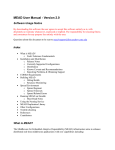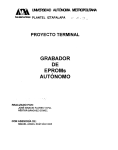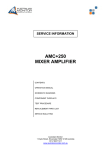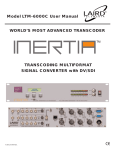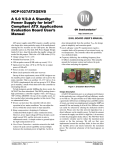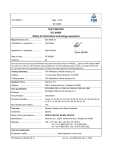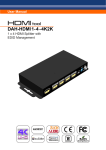Download USER MANUAL - Schulz Electronic GmbH
Transcript
USER MANUAL LDY CW Diode Driver Power Supplies The LDY family of CW diode laser drivers is Lumina Power’ s second generation of high power laser diode drivers. As a laser diode driver, the LDY power supply acts as a programmable current source and delivers constant current based on the input program signal, Iprogram(+), which is normally 0-10V. All units are configured with a maximum current and maximum voltage capability, depending on the user’ s requirements. LDY power supplies will deliver current, as programmed, into any load, providing the voltage requirements of that load do not exceed the maximum rated voltage of the unit. When the required compliance voltage is higher then the maximum rated output voltage of the unit, the unit will limit output current. The new LDY family includes the following additional features: • • • • Pulse Control: The user can pulse the output of the LDY via a TTL signal. Previously, all analog control of the output had to be controlled via the Iprogram signal. The Pulse Control signal simplifies pulsing of the output. Crowbar: A high power transistor removes energy from the output of the power supply whenever the output is off. A Crowbar Monitor signal is provided to monitor the status of the Crowbar. Temperature Warning: A TTL signal warns the user that an overtemperature condition has developed in the power supply circuitry. The power supply is likely to shut down if the cause of the warning is not addressed. Current Limit Dip Switches: A bank of 4 DIP switches is provided to limit the output current to 16 settings between 110% and 56% of maximum output. This is a useful feature in the event the diode driver is to be used for multiple applications with some applications requiring less than the maximum rated current of the LDY. LDY power supplies utilize a proprietary low loss, high frequency power factor correction circuit which keeps power factor above 0.98. Power factor corrected power supplies use up to 30% less input current and meet stringent IEC harmonic requirements. The output inverter is a state-of-the-art zero voltage switching (ZVS) inverter which permits very high frequency power conversion with minimum losses and electromagnetic noise. LDY Diode Drivers - Theory of Operation (Refer to Figure 1) The LDY laser diode drivers were designed specifically for the OEM high power CW laser diode systems. OEM power supplies for the laser diode industry have the following requirements: • • • • • • • Safe laser diode operation Broad range of control of output current Safe rise/fall times Small size Power factor correction to conform with CE requirements Low conducted electromagnetic emissions Low leakage for medical applications Referring to the “ LDY Laser Diode Power Supply”block diagram, the following is a brief description of operation. AC Input Power Circuitry AC input power is processed through a line filter to reduce the conducted EMI to an acceptable level. The LDY line filter has minimum capacitance to ground to minimize leakage currents. Earth Ground stud is provided near the AC input terminals and should be connected to the system ground. Power Factor Correction Boost Inverter The rectified input power is next applied to power factor boost inverter. This inverter boosts the input voltage to 400VDC. In the process of boosting the input AC voltage, the input AC current is adjusted so that is always in phase with the input AC voltage. Without this power factor correction circuit, the AC input current would be delivered to the power supply in high amplitude, narrow spikes, having a high harmonic content. With power factor correction, the non-50/60 Hz harmonics are reduced to near zero. Since only the fundamental frequency is now used to deliver power, the efficiency of the power supply is improved considerably. One problem with standard input power factor correction circuits is that a high frequency switching circuit is placed across the line in the input side of the traditional input capacitor filter. This results in substantial switching noise conducted to the line. Lumina Power employs a proprietary soft-switching boost inverter which produces minimum switching noise, reduces switching losses, and results in a smaller heat sink associated with the power factor circuit. Zero Voltage Switching (ZVS) Inverter The ZVS inverter and the output transformer are used to step the 400VDC bus down to the appropriate output value. The ZVS inverter is the most modern high frequency/low loss/low noise topology utilized in power electronics today. Instead of running the inverter in a traditional PWM mode, the inverter is run in a phase shift mode. With the appropriate output inductor and the appropriate capacitance across each switching device, in this case MOSFETS, there are 2 virtually no switching losses in the inverter. The only losses in the devices are I R losses associated with the Drain/Source resistance of the MOSFETS. Therefore, the ZVS inverter also contributes to reduced losses, reduce EMI noise and a reduction in overall system heatsink requirements. Output Circuit The output filter is a two stage RC filter designed to keep ripple and output noise very low. For lower power units, such as the LDY-250, a single stage filter is used. Control Circuit The control circuit handles all the responsibilities associated with safe operation of the laser diode. Controlled rise and fall times, as well as tight current regulation, overvoltage and over power protection are controlled and monitored in the control circuit. Auxiliary Power All internal power supply requirements as well as the external +/-15V and +5V power supplies are derived from the power factor control boost inductor. All auxiliary power supplies are regulated by standard linear regulators. LDY-600/1000/1500-XX-YY SPECIFICATIONS XX = Ioutmax YY = Voutmax XX * YY cannot exceed Poutmax Model Poutmax Ioutmax Input Voltage LDY-600-XX-YY 600W 100-240VAC LDY-1000-XX-YY 1000W Can be configured from 10A to 100A LDY-1500-XX-YY* 1500W 100-240VAC Size (L x W x H) 9.9”x 7.2”x 2.5” 25.1 x 18.3 x 6.35 cm 200-240VAC Auxiliary Outputs: +5V @0.5A +15V @0.5A -15V @0.5A * LDY-1500 input voltage: 200-240VAC Maximum compliance voltage determined by maximum rated power RS-232 Option available Other outputs available upon request Input Voltage: Power Factor: See table above >.98 Interface Connector: Current Program: Current Monitor: Voltage Monitor: 15 Pin “D”Sub Female 0-10V for 0-Max Current 0-10V for 0-Max Current 0-10V for 0-Max Voltage Performance Pulse Width Range: Rise/Fall Time: Current Regulation: Current Ripple: Current Overshoot: Power Limit: 1.5msec to CW ~600usec (10% to 90% Full Current) 0.5% of Maximum output current <0.5% of maximum output current <1% of maximum output current Limited to maximum power with power fold-back circuit Environment Operating Temp: Storage: Humidity: Cooling: 0 to 40 oC -20 to 85 oC 0 to 90% non-condensing Forced air Regulatory Leakage Current: <250uA Approvals: Medical Safety: Industrial Safety Emissions/Immunity: UL60601-1, IEC 60601-1, EN 60601-1, CAN/CSA C22.2 No. 601.1-M90 UL60950 FCC 47 CFR Class A Emissions, EN55011:1998 Group 1 Class A Emissions, EN61000-3-2 Limits for harmonic current emissions, EN 610000303 Flicker, EN60601-1-2:2001 Electromagnetic emissions and immunity for medical equipment LDY-600/1000/1500 Interface Connector Type: 15 pin D-sub Female (Refer to Figure 2. LDY Interface Schematic) Pin # Functional Voltage Level Description High=RUN=+5V to +15V Low = OFF = 0V Enable (input) The Enable function turns the output section of the power supply ON and OFF. When the power supply is enabled, current is delivered to load as programmed via Iprogram(+), Pin 7, if the Pulse Control, Pin 8, is High and the Interlock, pin 3 is connected to interface GND. Rise times resulting from Enable are approximately 25msec. For pulsing, the Enable function should be set to ON, and the Pulsing Control, Pin 8, should be used. 2 Crowbar Status (output) High = Crowbar ON = +5V Low = Crowbar OFF = 0V The Crowbar Status reports the status of the shorting crowbar clamp across the output. The crowbar will short the output under two conditions: 1) When the output is not ENABLED via Pin 1, or, 2) if the output is ENABLED via pin 1 but the control circuitry has detected a no- load condition or a voltage requirement on the output that exceeds the maximum voltage rating of the unit. A TTL+5V signal on Pin 2 reports that the crowbar is shorting the output. To turn the crowbar off, an appropriate load must be connected to the LDD and the output must be turned off and on via Pin 1, ENABLE. 3 Interlock (input) Open = OFF Connect to GND = RUN The Interlock function must be connected to GND in order for output current to be delivered. It can beused for external interlock functions such as door or overtemp switches. 5 Vout Monitor: (output) 0 –10V = 0 –Voutmax The output voltage of the supply can be monitored by Vout Monitor. For LDY’ s with a maximum rated output voltage less than 10V, Vout Monitor = Vout. For output voltages greater than or equal to 10V, 0- 1 LDY Pin Name 10V = 0 - Voutmax. 6 Iout Monitor (output) 0 –10V = 0 –Iout max 7 Iprogram(+): (input) 0 –10V = 0 –Iout max 8 Pulse Control (input) 10 +5V @ 0.5A (output) TTL High = On TTL Low = OFF Default = Off The output current of the supply can be monitored by Iout Monitor. The power supply output current is set by applying a 0-10V analog signal to Iprogram(+). The output may be pulsed by applying a TTL signal to Pulse Control, pin 8. The amplitude of the output current pulse is determined by the voltage programmed via Pin 7, Iprogram(+). Rise fall times of <1msec are typical. Rise fall times of 500usec can be achieved with special order. When using the LDY as a CW diode driver, pin 8, the Pulse Control, must be set to TTL High in order for output current to be delivered. Pin 10, +5V, would be a convenient connection point for this. No output current will be delivered with pin 8 left unconnected. Auxiliary +5V power supply for user. Up to 0.5A output current capability. TTL High = High Temp TTL Low = Temp OK When temperature of main heat sink exceeds 65 Deg C, Pin 11, the Over-Temp Warning, will go to a TTL High to indicate unit is in danger of shutting down due to over-temperature condition. When temperature of main heat sink exceeds 75 Deg C, unit will shut down. 11 Over-Temp Warning 12 -15V @0.5A (output) Auxiliary -15V power supply for user. Up to –0.5A output current available. 13,14 +15V @0.5A (output) Auxiliary +15V power supply for user. Up to 0.5A output current available. 4,9,15 GND Interface return TABLE 1: LDY Interface Figure 2 LDY Interface INSTALLATION AND OPERATION OF LDY Diode Drivers IMPORTANT INSTALLATION NOTES • • LDY diode drivers are air cooled by internal fans. Do not restrict air flow near the input or output air vents of the power supply. If the unit overheats due to restricted air flow, it will shut down and remain off until the unit has cooled to a safe operating temperature. LDY units should be mounted in systems using 8-32 (or M4) bolts to secure the mounting flanges to mounting plate. SAFETY WARNING Because LDY units are designed for OEM applications, the user must connect AC input power to the power supply. Any input AC voltage must be considered extremely dangerous, and as such, care must be taken to connect AC input power to the unit. Figure 3 LDY Input Connections Figure 5 LDY Output Connections 1. CONNECTING TO DIODE LASER Figure 5 shows the location of the LDY output terminals. Connect diode laser load to the output terminals. Although CW diode laser applications are generally free of voltage spikes associated with high speed Quasi-CW applications, it is still good practice to keep connections between the diode laser and power supply as short as possible to avoid I2R losses in the wire. 2. INTERFACE CONNECTION Connect user system to 15 pin D-sub connector shown in Figure 4. (Although the user interface is typically designed by the user, Lumina Power can provide any assistance necessary to modify interface program and monitor levels) See Table 1 and Figure 2 for description of LDY Interface and the associated simplified interface schematic. IMPORTANT NOTE Make sure when connecting interface that the current program setting, Iprogram(+), is set no higher then the value required for operation. When AC power is applied and system is Enabled, output current will rise to this program value 3. INTERFACE INFORMATION BEFORE APPLYING AC POWER: The unit may be programmed for output current via Pin-7, the Iprogram function. But there are three interface control signals which must be properly set before the output will deliver current as programmed by Iprogram. a. INTERLOCK: Pin 3, the Interlock, must be grounded via Pins 4, 9 or 15 in order for the output to deliver current. b. PULSE CONTROL: Pin 8, the PULSE CONTROL pin, must be a TTL HIGH in order for the output to deliver current. The PULSE CONTROL function is used when the user wants to pulse the output. Because the default for PULSE CONTROL is TTL LOW = OFF, for CW operation, the PULSE CONTROL must be set to a TTL high. Refer to Section 7 for more information on pulsing. c. ENABLE: Pin 1, the ENABLE signal is a 5V to 24V signal used to turn the output section on. The ENABLE circuitry incorporates a soft start function which ensures rise times of approximately 15 to 20msec. CH 1 Iout 20A/div CH 2 ENABLE Response of Iout to ENABLE signal d. Iprogram: Pin 7. A 0-10V signal results in 0 to Ioutmax, as long as the rated compliance voltage of the driver is not exceeded. 4. Operating the LDD a. AC INPUT POWER CONNECTION Connect AC power connections to power supply input power terminals as follows (refer to Figure 3.):. • Neutral wire (16AWG) connected to the right contact of the AC input terminal (labeled N). • Line wire (16AWG) connected to the left contact of the AC terminal block. • Ground wire shall be crimped to a # 8 ring-lug and connected to the ground stud. IMPORTANT APPLICATON NOTE REGARING AC INPUT POWER AC Input wires should be at least #16 AWG, rated for at least 300V and 105DegC. IMPORTANT SYSTEM NOTE ON AC INPUT POWER LDY units are fused on both input lines. It does not matter which of the two AC inputs are designated Line or Neutral. AC input power requirements for LDY models are as follows: Table 2 LDY AC Input Power Requirements MODEL INPUT POWER LDY-600-XX-XX 100-240 VAC, 50/60 Hz, 7A @115VAC LDY-1000-XX-XX 100-240 VAC, 50/60 Hz, 12A @115VAC LDY-1500-XX-XX 200-240 VAC, 50/60 Hz, 9A @220VAC b. INTERFACE SETTINGS: Make sure INTERLOCK, Pin 3, is connected to GND and PULSE CONTROL, Pin 8, is set to TTL HIGH. c. APPLY INPUT AC POWER Turn ON AC power. After a few seconds the power supply fans should begin to run. d. PROGRAMMING OUTPUT CURRENT Program LDY power supply for desired output current. A 0-10V signal applied to Iprogram, Pin 7, will program the LDY diode driver for 0 to maximum rated output current. IMPORTANT APPLICATION NOTE When the power supply is enabled using the ENABLE signal, internal soft start functions limit the rise time of the output current to approximately 20msec. Once the power supply is enabled, the rise/fall time of the Iprogram(+) signal is approximately 600usec. e. ENABLE OUTPUT Apply +5V to +15V to ENABLE, Pin 1. The LDY will deliver output current as programmed. 5. Monitoring LDD output and performance: a. Current Monitor Power supply output current can be monitored via pin 6, Iout Monitor. A 0-10V signal will represent the output current from 0 to maximum rated output current. b. Voltage Monitor Power supply output voltage can be monitored via pin 5, Vout Monitor. A 0-10V signal will represent the output voltage from 0maximum rated output voltage. c. Crowbar Status The status of the output crowbar circuit can be monitored on Pin 2, the Crowbar Status. The crowbar will short the output under two circumstances: i. The ENABLE is OFF, or ii. The power supply has detected an open circuit. In this case, it is probable that no load has been connected to the power supply OR the load exceeds the maximum rated compliance voltage of the device. In this case, it is required to clear the Crowbar fault by turning the ENABLE off, connecting a proper load, and reapplying the ENABLE signal. d. Over-Temp Warning. The Over-Temp Warning signal monitors internal heat sink temperature and warns the user of an impending power supply shutdown. This switch is a 65DegC switch. When the internal heat sink temperature reaches 65 Deg C, a TTL High will be transmitted. When the internal heat sink temperature reaches 75Deg C, the unit will shut down. 6. Programmable Current Limit DIP Switches The LDY includes an internal DIP switch array which may be set to limit the maximum current. This is useful when an OEM customer would like to use a single model for a variety of systems, but has a laser diode system which does not require the maximum output current. In this type of situation, it is important to protect the laser diode from an overprogram error which could damage the laser diode. The following table shows the various DIP switch settings and resulting output current S1 S2 S3 S4 Imax Out OFF OFF OFF OFF 110% OFF OFF OFF ON 103% OFF OFF ON OFF 98% OFF OFF ON ON 92% OFF ON OFF OFF 88% OFF ON OFF ON 84% OFF ON ON OFF 80% OFF ON ON ON 77% ON OFF OFF OFF 74% ON OFF OFF ON 70% ON OFF ON OFF 68% ON OFF ON ON 65% ON ON OFF OFF 63% ON ON OFF ON 60% ON ON ON OFF 58% ON ON ON ON 56% For example, if an LDY is configured for a maximum output current rating of 60A, and the user would like to limit the maximum output current in a particular application to 37A, the DIP switch array should be set as follows: S1 S2 S3 S4 Imax Out ON OFF ON OFF 68% This will limit the current to 68% of 60A, which is 40.8A. When the unit is programmed with a 0-10V signal, the output will follow the program until the program voltage reaches 6.8V, at which point the output current will not rise any further. Units are shipped with all switches in the OFF position, which results in the ability to program the unit to 110% of its maximum rated output current. 7. PULSED OPERATION The LDY family of CW drivers are intended for CW applications. However due the fast response achievable with very high frequency switchmode power supplies, it is possible to pulse diode lasers at sub QCW speeds. The typical rise and fall times of the LDY units are between 800usec and 1msec. Therefore a rep rate of 200Hz to 400Hz is possible. Pulsing can be accomplished via the PULSE CONTROL function on Pin 8. A TTL HIGH must be applied to pulse the output on. The user may configure the pulse train as desired. Typical performance is shown below. Typical LDY Rise Fall Time CH 1 Iout 20A/div CH 2 ENABLE It is possible to configure LDY’s for rise and fall times up to 500usec, which would permit pulsing up to 600Hz. Consult the factory for faster rise/fall times. NOTE: It is not possible to use Enable, Pin 1, for pulsing since the ENABLE circuit includes a “soft start”is intended for turning on the power supply output slowly. The Enable function controls several soft-start features which do not permit pulsing. NOTE: For faster pulsing, refer to the data sheet for Lumina Power’s LDQCW power supplies. These units have rise/fall times of less than 25usec and can achieve output currents up to 200A. These units can pulse at frequencies up to 5khz, depending on the average power required. 8. Servicing LDY Diode Drivers LDY units have no serviceable parts. Do not attempt to repair or service this unit in the field. For further information, contact Lumina Power at 978-774-0179.

















